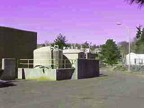 |
 |
 |
||
| Bar screen & grit chamber (left) and ferric chloride tanks (right). | Ferric Chloride Tanks | One of two trickling filters, |
The Clean Water Act of 1972 was designed to restore and maintain the chemical, physical and biological integrating of the waters of the United States. The main goals of the act were to make all waters safer for fishing and swimming by 1983 and to eliminate putting pollutants into the nation's lakes, rivers, and streams by 1985. In 1977 the Clean Water Act was defended and strengthening changes were added; this included provisions for enforcement and incentives for industries. Standards for toxic discharges were also set. In 1978 the continuation of the Clean Water Act's wetlands provisions were passed by one vote in the Senate.
In 1987 President Reagan vetoed the Clean Water Act re-authorization. There was enough support to override the veto and new measures established runoff controls, toxic controls, and estuary cleanup funding. Federal funds allocated to state clean-up programs were $400,000,000. The major reason that some businesses and community members do not support the act is due to the expense of implementing the program requirements.
The "Dirty Water Bill" introduced by Representative Bud Shuster would have allowed more toxins and raw sewage in waterways, and significantly effected the wetlands protections. At this time (2000) the goal for discharge into swimmable and fishable lakes and rivers is zero. The Clean Water Act must be reauthorized every five years.
WATER CONCERNS & SAFETY
The biggest pollution threat in the community is the mishandled disposal of industrial solvents. Other contamination may come from pesticides and fertilizers. Wells are monitored on a regular basis to assure that the water quality meets regulatory standards.
To protect our ground water keep oils, cans, trash, etc. out of the water recharge area; keeping the water clean is every citizen's responsibility. PBA (Perkasie Borough Authority) owns 165 acres of land in the Three Mile Run area. This serves as a well protection area so trash and other materials won't get in to the ground water. They also own or control a 100' diameter around wells located in the Perkiomen Water Shed.
WATER TESTING
To check water quality a minimum of 163 tests are performed annually. PBA has consistently met or exceeded (EPA) Environmental Protection Agency standards.
PBA issues a Consumer Confidence Report every year to update its customers on the quality , processing, and location of their water supply.
PRETREATMENT
During pretreatment, the first treatment step, large pieces of debris are removed as the the water moves through bar screens,; the screens trap sticks, leaves, rags, and other floating material. Then, in the grit chamber, air introduced into the system allows grit (such as sand) to settle to the bottom. The organic material remains suspended. Grit is transported to an approved landfill.
PRIMARY TREATMENT
Wastewater flows into the wet wells at the wastewater pumping station. Raw wastewater pumps carry the wastewater to primary treatment ( A flash mixer, flocculators, and primary settling tanks). Settable solids and 40 - 60 % of the suspended solids (those suspended or floating on the surface) are separated and removed from the wastewater.
Wastewater flows through primary settling tanks to allow suspended solids to settle to the bottom of the tanks. Sludge, the settled material is sent to a sludge well.
SECONDARY TREATMENT
Wastewater from the primary settling tanks flows into the two trickling filters. A trickling filter is a round filter filled with various sized rocks. The primary effluent is sprinkled over the rocks and allowed to trickle through the bed. The organic material in the wastewater is oxidized by small bacteria and other microorganisms attached to the rocks. The wastewater is converted to harmless biosolids by the bacteria.
CHLORINATION & DISINFECTION
Wastewater then flows to
the chlorination system. Liquid chlorine is used in the disinfection
process. Disease causing organisms are destroyed by this process.
The liquid from the chlorine contact tanks flows into the Perkiomen
Creek.
HANDLING OF SLUDGE
Solids removed must be thickened to remove excess liquid .A gravity thickener allows sludge to be discharged into a digester. Digestion takes place in an open tank and chemicals are added to coagulate the sludge in the filter press. The biosolids are stabilized and conditioned for use as a fertilizer. Approximately 75&% of the biosolids produced are land applied. Today the plant capacity is 4 million gallons a day and capable of serving 38,500 people.
 |
 |
 |
||
| Bar screen & grit chamber (left) and ferric chloride tanks (right). | Ferric Chloride Tanks | One of two trickling filters, |